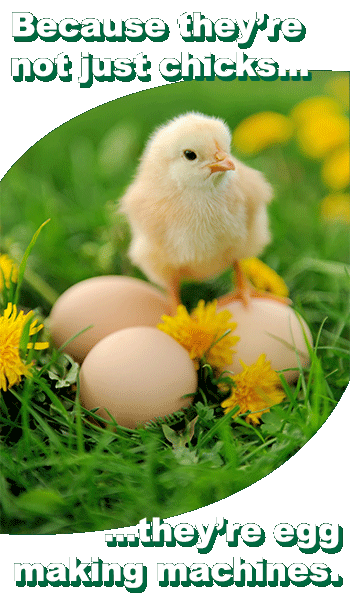STARTING CHICKS
- Be ready BEFORE chicks arrive
- Facilities should be clean, dry, and free from
drafts, with at least 2 inches of suitable litter on
the floor
- Be sure the heat source (brooder, heat lamps,
etc.) is working. Heat lamps should be about
20 inches above chicks, and raised weekly as the
birds grow.
- Be sure chicks are drinking water BEFORE feed
is provided. Use electrolytes in the water for the
first week.
NEVER allow chicks to run out of water!
- Keep waterers clean.
- Chicks should have feed at all times. The first
2 or 3 days some feed may be placed in paper
plates or in box lids in addition to the feeders.
- If “pasting up” is a problem, top-dress the feed
with a small amount of oatmeal.
TEMPERATURE
Chicks: Keep the temperature at 90-95° F the first few days. Gradually reduce the temperature about 5° F
each week until 70° F is reached. Take the temperature
at chick height.
Layers: Layers can tolerate a rather wide range of
temperatures without affecting egg production. Laying
house temperatures below 55-60 ° F increase the amount
of feed required to produce a dozen eggs.
LIGHT
Chicks: Start pullets on 2 days of continuous light (10
watt incandescent bulb per 200 square feet of floor
space). From 3 to 21 days, gradually reduce day length
to 15-16 hours. From 3 to 18 weeks, maintain a constant
day length of 10-12 hours or that dictated by natural day
length.
Layers: Artificial light will help maintain egg production
during the fall and winter. The use of artificial lights
may begin when the pullets are placed in the laying
house. Increase the amount of light 30 minutes per
week to 15-16 hours per day.
FLOOR SPACE
Chicks: Allow one square foot of brooder space per
chick through 8 weeks of age, and 2 square feet from 8
through 18 weeks of age.
Layers: Allow 3 to 4 square feet per bird.
FEEDER SPACE
Chicks: Provide one inch of feeder space per chick
through week 2; two inches per chick from 3 to 7 weeks,
three inches per chick from 8 to 18 weeks of age. A
20 lb hanging feeder should be adequate for 50 chicks.
Adjust height of feeders so that all the birds can eat easily
without wasting feed. The lip of the trough should be
even with the bird’s back.
Layers: Provide 4 inches of feeder space per bird. For
larger hanging feeders (40-45lbs), allow 6 feeders per
100 birds. Adjust feeder height as needed.
WATERING SPACE
Chicks (per 100 chicks): Provide 20 inches of trough
space or two 1-gallon fountains from day 1 to 2 weeks of
age. Provide 36 inches of trough space or three 1-gallon
fountains for weeks 3 through 12. Always provide plenty
of clean, fresh water, especially when starting baby
chicks.
Layers: Provide one 8-gallon gravity flow waterer or 8
linear feet of trough-type waterer for 100 layers from 12
weeks to production. No bird should be more than 15
feet from a waterer.
LITTER
Chicks: Floors should be covered with at least 2 inches
of suitable litter. Ground cobs, shavings, peat moss,
chopped straw, and commercial litter are common. Litter
should be clean, dry, free of dust, absorbent, and free
of injurious material. Stir litter frequently and remove
damp and/or caked litter. Add fresh litter as needed.
Layers: Provide at least 4 inches of suitable litter at
housing.
Available from Hartville Feed
Pullet Feeds
The following feeding program will help get your pullets off to a great start.
- Medicated with Amprolium to aid in the
prevention of coccidiosis
- Guaranteed levels of lysine and methionine;
essential amino acids for growth,
reproduction, and healthy skin and feathers
- High energy corn diets to promote growth
- Provides organic selenium to help maintain
a healthy immune system and cellular health
- Added vitamins and trace minerals to ensure
a balanced diet
- Contains specific vitamin D, source for strong
bones and livability
Layer Feeds
BLUE SEAL EXTRA EGG
Extra Egg is a super premium,
high energy, all natural pelleted
feed for laying hens. It is a corn
and soybean meal based high
energy, calcium fortified diet
designed specifically for layers.
LAYER MASH
Layer Mash is a premium, high
energy, all natural ground feed
for laying hens. It is a corn
and soybean meal based high
energy, calcium fortified diet
designed specifically for layers.
EGG MAKER PELLETS
Egg Maker Pellets is an economical, low energy
pelleted feed for laying hens.

|
Chick Start |
Chick Grow |
Chick Develop |
| Age in weeks |
0-6 wks |
7-12 wks |
13-18 wks |
| Energy Kcal / lb |
1,360 |
1,385 |
1,415 |
Feed Consumption
|
2.0 lb/bird |
4.5 lb/bird |
5.5 lb/bird |
| Crude Protein, min |
20.00% |
18.00% |
16.00% |
| Crude Fat, min |
3.00% |
3.00% |
3.50% |
| Crude Fiber, max |
4.00% |
4.00% |
4.00% |
|
Layer Mash |
Extra Egg Pellets |
Egg Maker Pellets |
| Energy Kcal / lb |
1,290 |
1,260 |
1,100 |
Feed Consumption
|
0.25 lb/bird/day |
0.27 lb/bird/day |
0.29 lb/bird/day |
| Crude Protein, min |
16.00% |
16.00% |
16.00% |
| Crude Fat, min |
3.00% |
3.00% |
2.50% |
| Crude Fiber, max |
4.00% |
4.00% |
7.00% |



